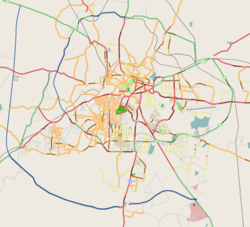Lal Bagh
|
Lalbagh ಲಾಲ್ಬಾಗ್ |
|
|---|---|
| Botanical Gardens | |

The Lalbagh Glass House in the Botanical Garden
|
|
| Location in Bengaluru, India | |
| Coordinates: 12°57′N 77°35′E / 12.95°N 77.59°ECoordinates: 12°57′N 77°35′E / 12.95°N 77.59°E | |
| Country | India |
| State | Karnataka |
| District | Bengaluru Urban |
| Metro | Bengaluru |
| Languages | |
| • Official | Kannada |
| Time zone | IST (UTC+5:30) |
Lalbagh or Lalbagh Botanical Gardens, meaning The Red Garden in English, is a well known botanical garden in southern Bengaluru, India. The garden was originally commissioned by Hyder Ali, the ruler of Mysore, and later finished by his son Tipu Sultan. It has a famous glass house which hosts two annual flower shows (26 January and 15 August). Lalbagh houses India's largest collection of tropical plants, has a lake, and is one of the main tourist attractions in Bengaluru. Lal Bagh is also home to a few species of birds. The commonly sighted birds include Myna, Parakeets, Crows, Brahminy Kite, Pond Heron, Common Egret, Purple Moor Hen etc.
Hyder Ali commissioned the building of this garden in 1760 but his son, Tipu Sultan, completed it. Hyder Ali decided to create this garden on the lines of the Mughal Gardens that were gaining popularity during his time. Hyder Ali laid out these famous botanical gardens and his son added horticultural wealth to them by importing trees and plants from several countries. Hyder Ali deployed people from Thigala community who were extremely good in gardening. The Lalbagh gardens were commissioned by the 18th century and over the years it acquired India's first lawn-clock and the subcontinent's largest collection of rare plants. A menagerie established in the 1860s was under the charge of G.H. Krumbiegel in 1914. Captain S.S.Flower reported that it included a Court built between 1850 and 1860 having tigers and rhinoceros; an aviary; a monkey house with an orangutan; a paddock with blackbuck, chital, Sambhur deer, barking deer and a pair of emus; a bear house and a peacock enclosure.
The Lalbagh gardens are based on the design of the Mughal Gardens that once stood at Sira, at a distance of 120 km from Bengaluru on the main NH4 at Tumkur District in Karnataka. This is amply supported by ASI (Archaeological Survey of India) and other historical records. At that time, Sira was the headquarters of the strategically important southernmost Mughal "suba" (province) of the Deccan before the British Raj.
...
Wikipedia

